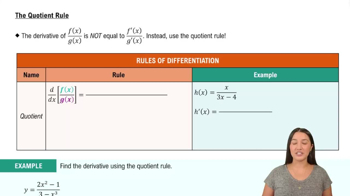Table of contents
- 0. Functions7h 52m
- Introduction to Functions16m
- Piecewise Functions10m
- Properties of Functions9m
- Common Functions1h 8m
- Transformations5m
- Combining Functions27m
- Exponent rules32m
- Exponential Functions28m
- Logarithmic Functions24m
- Properties of Logarithms34m
- Exponential & Logarithmic Equations35m
- Introduction to Trigonometric Functions38m
- Graphs of Trigonometric Functions44m
- Trigonometric Identities47m
- Inverse Trigonometric Functions48m
- 1. Limits and Continuity2h 2m
- 2. Intro to Derivatives1h 33m
- 3. Techniques of Differentiation3h 18m
- 4. Applications of Derivatives2h 38m
- 5. Graphical Applications of Derivatives6h 2m
- 6. Derivatives of Inverse, Exponential, & Logarithmic Functions2h 37m
- 7. Antiderivatives & Indefinite Integrals1h 26m
- 8. Definite Integrals4h 44m
- 9. Graphical Applications of Integrals2h 27m
- 10. Physics Applications of Integrals 2h 22m
1. Limits and Continuity
Finding Limits Algebraically
Problem 13b
Textbook Question
Finding Limits
In Exercises 9–24, find the limit or explain why it does not exist.
lim h →0 ((x + h)² ― x²)/h
 Verified step by step guidance
Verified step by step guidance1
Recognize that the given expression is a difference quotient, which is often used to find the derivative of a function at a point. Here, the function is f(x) = x².
Substitute the expression (x + h)² for f(x + h) in the difference quotient: ((x + h)² - x²)/h.
Expand the expression (x + h)² using the binomial theorem: (x + h)² = x² + 2xh + h².
Substitute the expanded form back into the difference quotient: ((x² + 2xh + h²) - x²)/h.
Simplify the expression by canceling out x² and then dividing each term by h: (2xh + h²)/h = 2x + h. Now, take the limit as h approaches 0, which results in the derivative of x² at x.
 Verified video answer for a similar problem:
Verified video answer for a similar problem:This video solution was recommended by our tutors as helpful for the problem above
Video duration:
3mPlay a video:
Was this helpful?
Key Concepts
Here are the essential concepts you must grasp in order to answer the question correctly.
Limits
A limit is a fundamental concept in calculus that describes the behavior of a function as its input approaches a certain value. It helps in understanding how functions behave near specific points, which is crucial for defining derivatives and integrals. In this case, we are interested in the limit as h approaches 0, which is essential for evaluating the expression given.
Recommended video:

One-Sided Limits
Difference Quotient
The difference quotient is a formula that represents the average rate of change of a function over an interval. It is expressed as (f(x + h) - f(x)) / h, and is used to derive the derivative of a function. In the given limit problem, the expression ((x + h)² - x²)/h is a difference quotient that simplifies to find the derivative of the function f(x) = x².
Recommended video:

The Quotient Rule
Derivative
The derivative of a function at a point measures the instantaneous rate of change of the function at that point. It is defined as the limit of the difference quotient as the interval approaches zero. In this exercise, finding the limit will ultimately yield the derivative of the function f(x) = x², which is a key application of limits in calculus.
Recommended video:

Derivatives

 5:21m
5:21mWatch next
Master Finding Limits by Direct Substitution with a bite sized video explanation from Callie
Start learningRelated Videos
Related Practice







